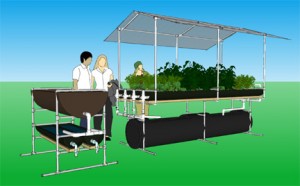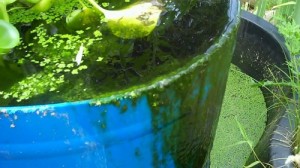Who wants to grow food in a box? Maybe not a lot of you yet but you just might after reading this story.
David Epstein, D.O. a holistic osteopathic physician and Kenneth Lovell, P.E., a professional engineer have developed Bioponica, a food production system that turns food, yard and body waste into feed and then from feed to food. The system works by converting waste, that is more often than not sent to a landfill, into worm castings and worm teas that are used to fertilize soil-less hydroponic plant beds. Waste products used include grass clippings, table scraps, and other sources of carbon and nitrogen rich waste.
 “It is unfortunate that we have relied on our municipalities to dispose of waste, whether that be urine, food or yard trimmings, “ said Epstein. “It is not practical or sustainable. When nutrients that come from the environment or from the food we eat are buried in landfills or else incinerated then we lose that valuable resource and it becomes a greenhouse gas that negatively impacts our climate and environment. The alternative is to recycle nutrients with the least amount of effort and cost.”
“It is unfortunate that we have relied on our municipalities to dispose of waste, whether that be urine, food or yard trimmings, “ said Epstein. “It is not practical or sustainable. When nutrients that come from the environment or from the food we eat are buried in landfills or else incinerated then we lose that valuable resource and it becomes a greenhouse gas that negatively impacts our climate and environment. The alternative is to recycle nutrients with the least amount of effort and cost.”
According to a company release, the system also hosts the growth of algae and duckweed, along with the microbes and aquatic animals that feed on the algae. All this, plus earthworms, become food for the fish. Yes, you read correctly. Bioponica is designed to use waste to feed fish in large-scale fish farms similar to the Farm in a Box aquaponic system.
So on top of the fish farm is a table, or garden, that is designed to grow micro-greens and wheatgrass along with your variety of edible and medicinal plants. In other words, you can grow your own salad. The fertilizer for your greens comes from the fish below, which convert the waste into plant feed.
“When growing high value crops such as these, the return on investment is less than one year. And without having to purchase fish food or fertilizer the cost is limited to a small electric bill for water pumps and labor,” said Epstein. He continued by explaining that labor is reduced because unlike conventional, in-ground gardening there are no weeds, soil-borne disease nor need to turn compost into the soil.
 “By converting carbon and nitrogen rich waste into fish and plant food we are effectively sequestering carbon turning it into a food before it escapes as a CO2 gas,” said Lovell. He continued by explaining that the system purifies as it conserves water. They are engineered to optimize growing area and store up to 40 gallons of water per linear foot, meaning they double as rainwater containment.
“By converting carbon and nitrogen rich waste into fish and plant food we are effectively sequestering carbon turning it into a food before it escapes as a CO2 gas,” said Lovell. He continued by explaining that the system purifies as it conserves water. They are engineered to optimize growing area and store up to 40 gallons of water per linear foot, meaning they double as rainwater containment.
Lowell continued, “The tables capture heat and warm the water within the fish tanks. On cool nights, the heated thermal mass of water returns to the beds, warming the plant area to extend the growing season into colder months.”
The Bioponica garden systems are made to support indoor or outdoor growing and even come with a UV filtered polycarbonate roofing option to keep warmth in and rain off the tables. This options keeps the temperature, CO2 and nutrient load stable.
So if you’re looking for a creative way to both recycle waste and grow your own greens, then consider trying out Bioponica.

